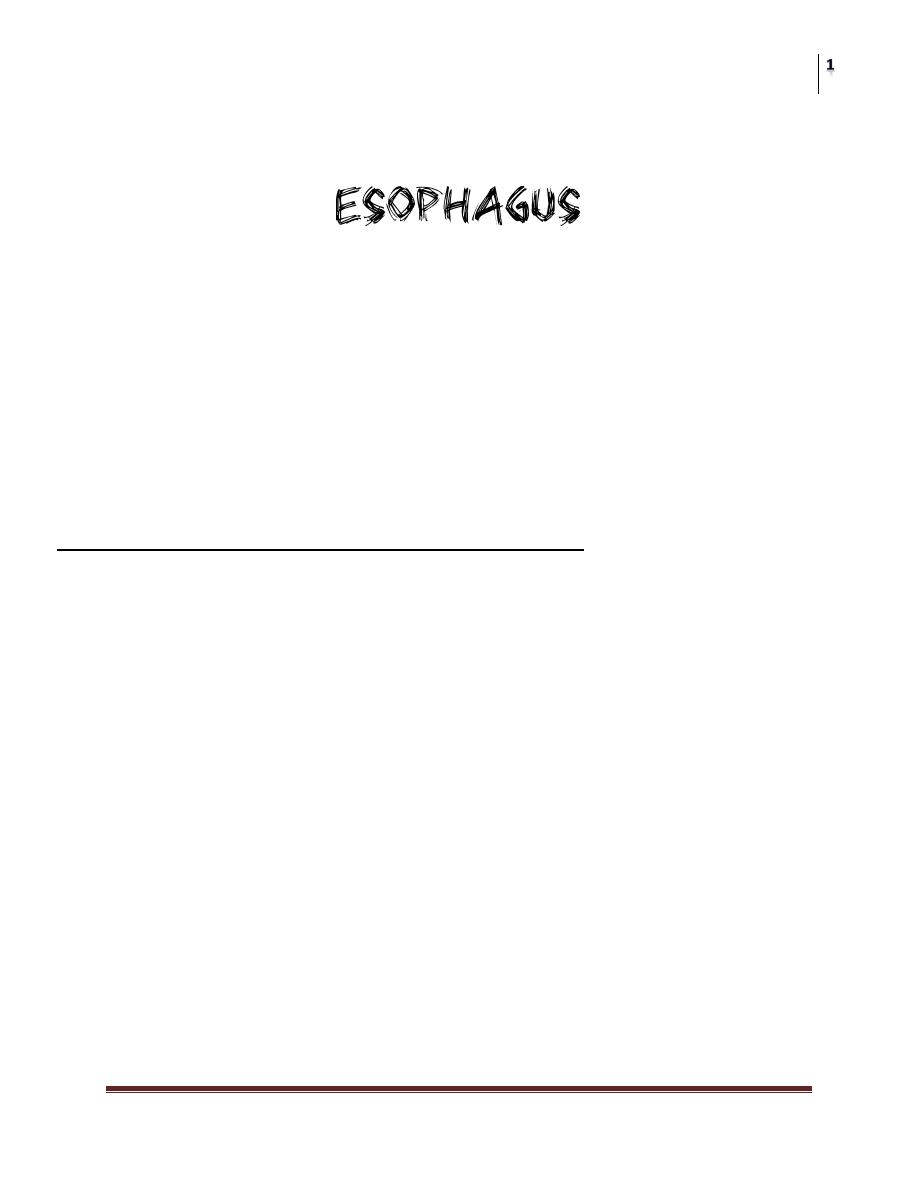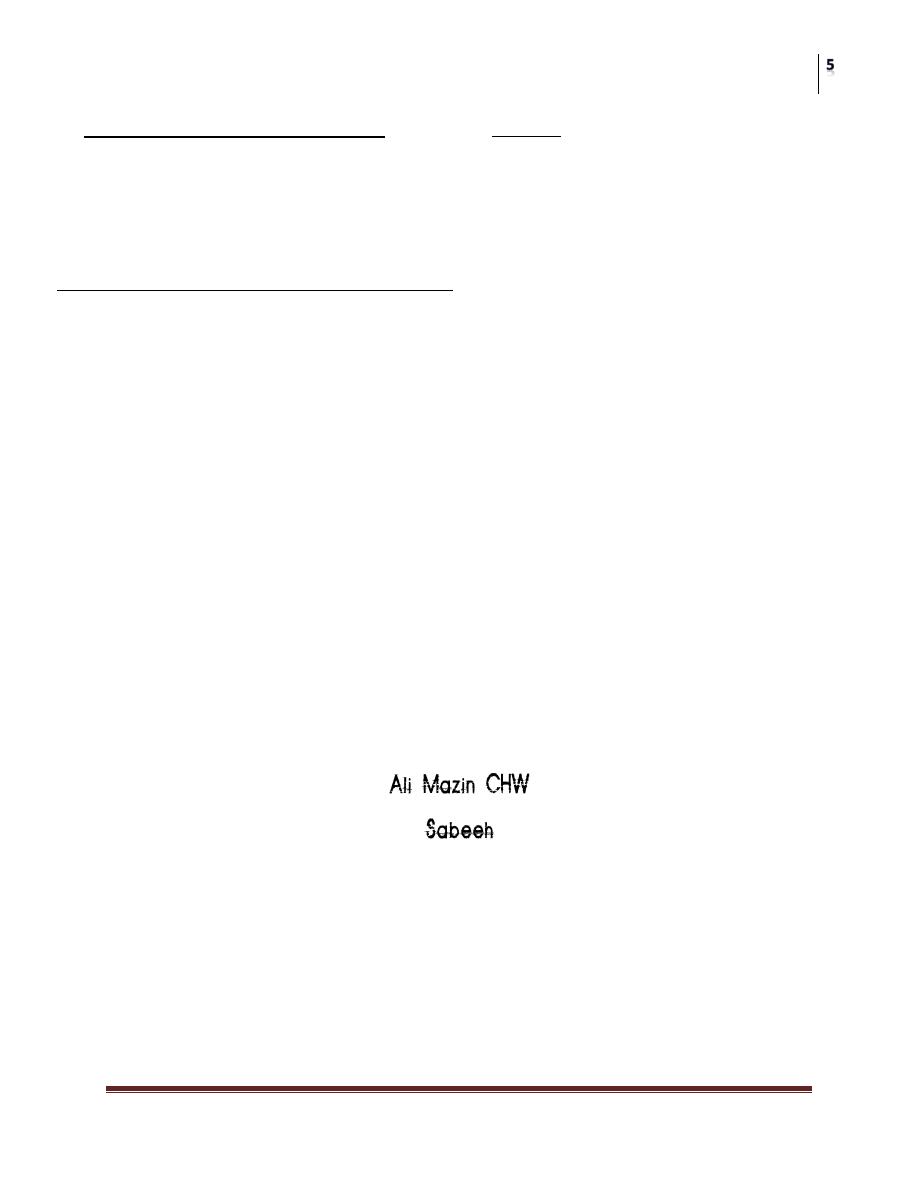
Surgery
Esophagus
Prof. Dr. Waleed Mustafa
Lec. 2
SURGERY
Prof. Dr. Waleed Mustafa
Lec.2
Disorders of esophageal motility
Functional disorders of the esophagus
Are those conditions that interfere with the normal act of swallowing or produce
dysphagia without any associated intra-luminal, mural organic obstruction or
extrinsic compression.
Upper esophageal sphincter dysfunction:
Crico pharyngeal dysfunction (oro pharyngeal dysphagia):
Symptoms complex that result when there is a difficulty in propelling liquid or solid food
from the pharynx into the upper esophagus.
Causes:
1. Neurogenic: CNS (MS), vascular (CVA), tumors, trauma.
2. Myogenic: myasthenia gravis, inflammatory (poly myositis).
3. Structural: diverticulum
4. Mechanical: intra or extra luminal.
5. Iatrogenic: surgical or irradiation.
6. Gastro esophageal: reflux.
Motor disorders of the body of the esophagus
1. Achlasia of the cardia.
2. Diffuse esophageal spasm & related hyper motility disorders
Achalasia of the cardia
Is a disease entity of unknown etiology Characterized by absence of peristalsis in the
body of the esophagus, a high resting pressure at the (LES) and failure of this
sphincter to relax in response to swallowing .It is translated from Greek and means
failure of relaxation.

Surgery
Esophagus
Prof. Dr. Waleed Mustafa
Lec. 2
Pathology:
In achalasia, the body and the upper segment of the esophagus become dilated, tortuous
& hypertrophied .The most specific histological abnormality found by (E.M) is the
degeneration or disappearance of the ganglion cells of the Auerbach’s plexus.
Motility: In achalasia, a hypertensive (LES) with incomplete or no relaxation on
swallowing & aperistaltic esophageal body could be demonstrated by manometry.
Etiology:
Many theories were advanced to explain the etiology of achalasia. The most widely
acceptable & popular one attributes the condition to a neuromuscular dysfunction
affecting both the narrowed and the dilated segments of the esophagus and not merely
the (LES).
Clinical features:
Achalsia can occur at any age. The highest incidence is (25-60).
Mostly equal sex incidence or > in female.
The duration of symptoms (Days to years)
The onset ,sudden or insidious .sudden( emotional stress )
Symptoms:
1- Dysphagia
2- Regurgitation.
3- Pain.
4- Weight loss &Cachexia.
5- Emotional Disturbance.
6- Respiratory symptoms.
7- Heart burn (bact. Fermentation) .
Diagnosis:
1- CXR: Absence of gastric air bubble. Visible Esophagus. Fluid level.
2- Barium Swallow: Diagnostic
Dilated Esophagus ,full of barium ,
Normal mucosal lining ,food residue
Little barium passed to the stomach
Morphological forms : Cork-Screw, Cucumber ,Tortuous & Sigmoid
Bird s beak appearance

Surgery
Esophagus
Prof. Dr. Waleed Mustafa
Lec. 2
3- Esophagoscopy: To confirm the diagnosis & to exclude other path.
4- Manometry: Absence of peristalsis (body), high LES pressure.
Differential diagnosis:
1. Diffuse esophageal spasm
2. Systemic sclerosis
3. Organic obstruction( stricture , tumors)
Treatment:
1. Medical treatment: adalat, isordil
2. Dilatation: (bougienage) pneumatic or hydrostatic
3. Surgery: Heller’s cardio myotomy ---Thoracic approach
---Abdominal approach
Recently: Laparoscopic cardio myotomy
Complications of achalasia
1. Those related to retention & stasis ( Retention esophagitis )
2. Air way obstruction & repeated chest infection .
3. Pre malignant (squamous cell carcinoma )
Perforation of the esophagus
1. Esophageal perforation following instrumentation either by the rigid esophagoscope
or by bougienage.
2. Traumatic perforation, Foreign bodies ingestion or blunt and penetrating trauma
3. Spontaneous rupture (Boer-haave’s syndrome) due to the strian of emesis with or
without predisposing disease.
The sites of the normal anatomical constriction are the most common sites of perforation.
The consequence of the perforation is the contamination of the peri-esophageal space
with the digestive fluids, food and bacteria, can leads to extensive suppuration
.Perforation of the cervical esophagus can extend into the mediastinum along the
facial planes. The upper 2/3 of the esophagus will perforate into the rt. Pleural cavity
while the lower 1/3
rd
will perforate into the lt. Pleural cavity. Rarely the intra-
abdominal esophagus may perforate leading to peritonitis.

Surgery
Esophagus
Prof. Dr. Waleed Mustafa
Lec. 2
Clinical manifestations:
Pain, Fever, Dysphagia, Cervical pain or crepitation, Dyspnea, Pneumothorax and in
severe cases dyspnea and cyanosis.
Chest X-ray: Mediastinal emphysema. Pleural effusion
Barium study: can localize the site of perforation.
Treatment: Medical( NBM=NPO), IVF, Nasogasric feeding Surgical to close the
perforation.
Stricture of the Esophagus
1. Caustic Strictures:
It is the stricture resulting from the ingestion of solid or liquid caustics most frequently
seen in children who have accidentally swallowed the material or in adult who have
ingested the material for suicidal purposes.
The chemicals included alkaline caustics, acids or acid- like & household bleaches.
Strong alkalis (Na&KOH). It can burns of the pharynx,larynx,Esophagus &Stomach
Symptoms: Ranges from (minimal to shock). Dyspnea may occur.
Management:
1. Identification of the etiological agent.
2. Administration of the neutralizing agent.
3. Assessment of the extent of the injury.
4. Early Esophagoscopy to determine whether there is esophageal injury or not.
5. Cortico steroid decreases the degree of stricture.
6. Antibiotics together with steroid for (3-6 week).
7. Barium –swallow two weeks later to see if there is stricture or not.
8. Dilatation (Bougenage) may be needed after (3-4 weeks) and many patients need
regular dilatation.
9. May need esophageal replacement.
ESOPHAGEAL STRICTURE IS A PRE MALIGNANT

Surgery
Esophagus
Prof. Dr. Waleed Mustafa
Lec. 2
2. Reflux Esophagitis and Stricture: Esophageal stricture secondary to the reflux of
acid or alkaline secretions into the esophagus caused by esophagogastric
incompetence as a result of hypotensive (LES).
Pathologically it is a continuous process of destruction and healing that may stop at
any stage or may progress to fibrosis, stricture with the resulting dysphagia.
Stricture secondary to reflux are of three types:
1. Low stricture occurs at the esophagogastric junction.
2. High stricture occur at higher level ,associated with barrett esophagus; it is an
acquired condition in which the squamous epithelium has been eroded by the
damaging effects of GE reflux and has subsequently been replaced by columnar
junctional epithelium, it is a rare ,but it is PRE MALIGNANT and the malignancy is
adenocarcinoma .
3. Long stricture rarest type occurs in postpartum vomiting.
Treatment: 1- Bougienage (Dilatation )
2- Surgery: Resection
End of the lec.
